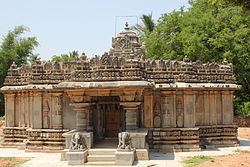District Tumkur District | Time zone IST (UTC+5:30) | |
 | ||
The Lakshminarasimha temple, dedicated to the Hindu god Vishnu is located in the village of Vignasante in the Tumkur district of Karnataka state, India. It was built in 1286 A.D. during the rule of the Hoysala empire king Narasimha III. The art historian Adam Hardy categorizes the architectural style as three shrined temple with closed mantapa, the basic building material being Soap stone. The monument is protected by the Karnataka state division of the Archaeological Survey of India.
Temple plan
The temple has all the basic features of the Hoysala architectural idiom. According to art historian Gerard Foekema, being a triple vimana (cella or shrine) construction it qualifies as a trikuta plan although only the central shrine has a tower (called shikhara) over it. The entrance to the temple is through an open pillared hall or porch (mukhamantapa) followed by a closed hall (mantapa or navaranga). The porch consists of an awning supported by lathe turned half pillars and parapets on either side. The decor on the parapet outer wall, the domical ceiling, the lintel over the entrance and the pillars shows the good taste of the Hoysala artisans. The inner wall of the shrine is square and plain where as the outer wall is stellate (star shaped) with numerous recesses and projections that are used for decorative relief. The closed hall which has no windows connects to the sanctum via a vestibule (called sukhanasi). The vestibule also as a tower (also called sukhanasi) which looks like a low protrusion of the main tower over the shrine. The outer wall of the vestibule is decorative but inconspicuous because it appears like a short continuation of the shrine outer wall. The ceiling of the closed hall is supported by four lathe turned pillars which divide the ceiling into nine decorated bays.
At the top of the shrine tower is the kalasha, a decorative water-pot like structure that is placed over a large ornate dome (Foekema calls it the "helmet"). This dome is the largest piece of sculpture in the temple measuring up to 2m x 2m. The design of the tower, according to art historian Percy Brown, is a characteristic feature to the Hoysala art. According to Brown, the stellate form of the base of the shrine with its projections and recesses is carried through the tower giving it a "fluted effect". The tower is divided into tiers with each tier diminishing in height and culminating in an umbrella like structure. Brown also claims the lathe turned pillars with four brackets above are a signature style of the 11th-13th century Chalukya-Hoysala architectural idiom.
